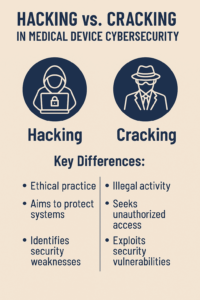
In cybersecurity, the terms “hacking” and “cracking” are often used interchangeably—but they have very different meanings, especially when it comes to medical devices.
For manufacturers developing FDA-regulated products, understanding the difference isn’t just academic. These concepts shape how you approach threat modeling, penetration testing, and regulatory documentation.
In this article, we’ll clarify the definitions of hacking and cracking, explain how they apply to medical device security, and show why both matter for compliance and patient safety.
What Is Hacking?
Hacking refers to the act of exploring, probing, or testing a system to understand how it works—sometimes to find vulnerabilities or weaknesses. While hacking can be malicious, the term increasingly refers to ethical or authorized activities, such as:
- Penetration testing
- Reverse engineering
- Security auditing
In medical device cybersecurity, ethical hacking is used to uncover flaws before attackers do.
Real-World Example
A manufacturer hires a cybersecurity firm to ethically hack a wearable monitor. The team simulates attacks on its Bluetooth communication to identify weak authentication mechanisms and recommend fixes.
What Is Cracking?
Cracking, on the other hand, refers specifically to malicious or unauthorized manipulation—typically with the intent to bypass security controls, remove protections, or exploit the system for gain.
Common cracking behaviors in the medical device space include:
- Removing firmware update validation checks
- Spoofing device telemetry
- Circumventing encryption or secure boot
Cracking often violates laws and regulatory requirements. Unlike ethical hacking, it is not authorized or constructive.
Real-World Example
An attacker cracks an infusion pump’s firmware to disable dosage limits. The altered device is then used in a gray-market setting or research lab—putting users at risk.
Key Differences: Hacking vs Cracking
| Aspect | Hacking (Ethical) | Cracking (Malicious) |
|---|---|---|
| Intent | Security testing, exploration | Bypass protections, cause disruption |
| Authorization | Typically authorized by manufacturer | Unauthorized, often illegal |
| Common Uses | Pen testing, vulnerability analysis | Firmware tampering, IP theft, spoofing |
| Regulatory Role | Supports FDA submissions | Must be addressed in threat models |
Why This Matters for Medical Device Manufacturers
Under the FDA’s 2025 Cybersecurity Guidance, manufacturers are expected to:
- Identify credible threats during development
- Conduct vulnerability testing (e.g., ethical hacking)
- Model risks from unauthorized access (e.g., cracking)
Failing to distinguish between legitimate testing and potential exploits can lead to incomplete threat models, security gaps, or submission delays.
Common Hacking and Cracking Scenarios in Devices
🛠️ Hacking Use Case
A third-party performs source-code review and fuzz testing to find input-handling bugs in a Bluetooth stack. These activities strengthen the Secure Product Development Framework (SPDF).
⚠️ Cracking Use Case
A cybercriminal exploits a device’s USB debug port to bypass authentication and extract encryption keys, then sells that firmware online.
How to Address Both in Your Cybersecurity Plan
- Support hacking through penetration testing, code review, and bug bounty programs.
- Mitigate cracking through:
- Secure boot and firmware signing
- Tamper resistance and code obfuscation
- Cryptographic key protection
- Logging and anomaly detection
Document both sets of risks and countermeasures in:
- Your threat model
- Your FDA eSTAR submission
- Your postmarket surveillance plan
Final Thoughts
Understanding the difference between hacking and cracking helps medical device manufacturers build stronger defenses and align with FDA cybersecurity expectations. Ethical hacking is a proactive measure to find weaknesses. Cracking is a threat vector to be mitigated.
Both must be addressed in your secure development lifecycle, tested, and documented to ensure patient safety and regulatory approval.
Partner With Blue Goat Cyber
At Blue Goat Cyber, we help medical device companies strengthen their cybersecurity posture with FDA-ready threat modeling, penetration testing, and secure firmware validation.
👉 Schedule a consultation today to assess your risk from both hackers and crackers.
